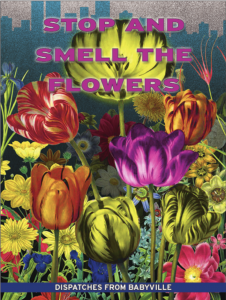
I have never been the kind of person who knows the names of flowers. I couldn’t tell a hydrangea from a hyacinth if my life depended on it. My main interest in flowers has been in their utility as metaphors. Until the pandemic.
Now, very much to my surprise, I find that I am interested in things that bloom. When I spot a flower, I have the urge to identify it, learn its name, admire its colors and contours. More than anything, I like to stop and smell the flowers. Literally. Incessantly. I have trespassed in people’s front yards to get a sniff. I have stopped sidewalk traffic.
When, I ask you, did the flowers of Brooklyn get so resplendent?
Have you smelled a lilac lately? I mean, deeply drank in its aroma? I can’t recommend it enough. It will renew you.”
I’m not the only one who’s noticed. At the start of spring, my Facebook feed was flooded with flower posts. In lieu of their children’s faces, my friends marveled at the loveliness of lilies, daffodils and, most notably, tulips.
Oh, the tulips.
We — hardened, jaded, New-York-tough city dwellers — lost our minds over the tulips this year.
I lack the poet’s tongue to wax sufficiently rhapsodic over flowers. I’m no Longfellow. But back in March, I was walking my 9-year-old to school in the morning, down the same street we always walk down, past the grays and browns and blacks that make up a sidewalk landscape, and suddenly, there was a burst of yellow. Bold. Brillant. Defiant. Three or four sunshine tulips, in a tree bed, their petals beginning to flare.
The tulips were impossible to ignore. You simply could not walk past them.
“Good morning!” they greeted us.
“Have a wonderful day at school!” they cried.
“If the last few months of this apocalyptic winter of our discontent have left you despairing and contemplating the possibility that all joy and beauty and hope have been extinguished,” they said. “Despair no longer! For we, tulips, have nevertheless persisted! Joy and hope and beauty have persisted! You, too, have persisted! So, crack a smile!”
They were loquacious suckers.
At first, it was just a few tulips here and there, peppering the neighborhood. But every day, they proliferated. Soon, their lovely, vibrant heads – orange, yellow, red– were popping out of the earth in every front yard, every tree bed, every planter.
My favorite were the two-toned tulips, with stunning magenta petals, edged in yellow. They looked like sunsets. I defy you to walk down a quiet Park Slope side street on a sunny afternoon, encounter a sunset tulip and not be suffused with the exquisite glory of living.
I have become a flower lover. It is an unlikely turn of events. What can I say? Life is surprising.
To celebrate my anniversary in April, my husband and I spent an afternoon at the Met, which marked our joyful return to museum-going. Crossing Park Avenue on our way home, I found myself approaching a congregation of tulips the likes of which I’d never known. In fact, this is untrue. I’d seen these tulips every year, because they are always there, on the island separating the northbound traffic of Park from the southbound. But this year, they stopped me in my tracks.
An unimaginable abundance of tulips — hundreds of them — lined up in neat rows, like little soldiers of good cheer, waving in the breeze.
“Oh my God,” I said to my husband. “They’re magnificent.”
“I know,” he agreed.
I turned to him and snorted. “And people said New York was dead.” Only I didn’t use the word “people.” I used a noun not suitable for print, an expletive almost as colorful as the tulips.
It takes a dark, cold winter to appreciate the spring. And the winter that just passed – it was a doozie. It was so unremitting in its bleakness that more than once, strangers confessed to me their inability to bear it all while waiting for elevators and for the light to change and on line in bodegas. After all of that fear and despair and the barren, terrible cold, finally there was light and new life and color and hope. Finally there were tulips.
As spring blooms to summer, the tulips have cast their petals to the ground, but there are other flowers appearing. Already, the lilacs are blooming.
Have you smelled a lilac lately? I mean, deeply drank in its aroma? I can’t recommend it enough. It will renew you.
But you don’t have to take it from me. Listen to Walt Whitman, father of free verse, the quintessential Brooklyn poet. This is from “When lilacs last in the dooryard bloom’d,” a poem which is about loss and beauty and continuing on:
“In the dooryard fronting an old farm-house near the white-wash’d palings,
Stands the lilac-bush tall-growing with heart-shaped leaves of rich green,
With many a pointed blossom rising delicate, with the perfume strong I love,
With every leaf a miracle—and from this bush in the dooryard,
With delicate-color’d blossoms and heart-shaped leaves of rich green,
A sprig with its flower I break.”
Every leaf a miracle.
Indeed.



